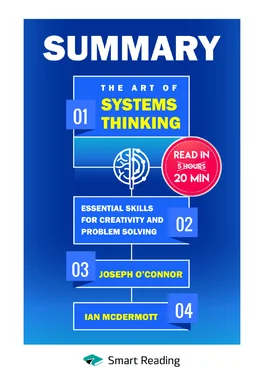Summary: The Art of Systems Thinking. Essential Skills for Creativity and Problem Solving. Joseph O’Connor, Ian McDermott
Автор:
Joseph O’Connor, Ian McDermott
Оригинальное название:
The Art of Systems Thinking. Essential Skills for Creativity and Problem Solving
www.smartreading.ru
Systems in a World of Systems
We are all systems living in a world of systems. The human body is an excellent example of a system consisting of a myriad of systems that work in harmony: immune, digestive, blood-vascular and many others. The cities in which we live are also complex systems that work in combination with other complex systems. We use systems in everyday life, we work in organizational systems, and planet Earth is a system rotating in the solar system. At the same time, we are taught from our childhood to use mostly formal logic, which in most cases succumbs to complexity and multi-pass systems. To deal efficiently with difficult situations, solve complicated problems and achieve success in various areas of life (business, health maintenance, personal relationships, sports, etc.), it is very important to learn how to operate in a systems thinking mindset and realize its importance.
Systems thinking teaches us to be modest and understand how complicated, contradictory, and unpredictable the world is. Our consciousness, even with the help of the most advanced computers, is not able to fully understand the world and estimate all the consequences of our actions, which quickly spread like ripples across water. Systems thinking provides us with the keys to understanding the world, because by concentrating on the nature of the connections between elements you can find many similar structures and rules of operation of completely different systems – financial, human, marketing, technical, and physiological.Once you understand the pattern of a functioning system, one can learn how to effectively predict its behavior and influence it. This means that systems thinking allows you, without spending years of life studying specific areas of knowledge, to understand how a variety of systems work.
Thinking Beyond the Obvious
A system is an entity, the interconnected parts of which function as a whole. Any system consists of smaller systems and, in turn, is part of even larger systems. It is thanks to the interaction of the parts and the connections between them that a system maintains its existence. If something is added to or removed from a system, it will change as the location of parts within the system can also be decisive for its existence.
Systems thinking is focused on the system as a whole, on its parts, as well as on the connections between the parts. The properties of a system are the properties of the whole, the individual parts of which do not possess these properties individually. Therefore, systems thinking begins with the study of the whole – from the general to the particular. To understand the properties of a system, one must observe it in action. And by understanding how one system works one can understand the behavior of other systems since it does not depend on the parts of the systems, but rather on the relationships between the parts.
The basic property of a system is that by dividing it into its parts, you will get not several systems, but a damaged and non-operable system. Neither the car’s engine nor its carburetor will go far on its own. When we begin to study the parts of a system separately, another danger lies in wait for us – we lose track of and miss the connections between the parts that are fundamentally important for the formation of the properties that interest us. In this case, our understanding becomes incomplete and false, and our conclusions incorrect, perhaps even harmful.
Analysis – the breaking down of a system into its parts – gives us knowledge, and synthesis – combining parts into a whole – helps us understand. Breaking down a system (analysis) in order to understand what it consists of and how each of the parts works can also be very helpful if done right.
The behavior of a system depends on its structure; when the structure changes, the system changes.The more complex the system is, the less predictable its properties are. The properties of a system are called emergent, or arising, because they arise only in the process of its operation: individual pictures turn into a cartoon when the projector starts operating; when a car is moving; when a whirlpool suddenly appears in the river; when a rainbow is born when water splashes. Our consciousness is also an emergent property, created by millions of neuron connections.
In the world of systems, "bigger" does not mean "better".There is an upper limit to the growth of systems, after which they become too bulky, difficult to manage, and break down more often. Therefore, overcomplicated human-created systems, such as organizations, should be ideally divided into smaller ones, forming intermediate connections and management levels.
The complexity of systems can be characterized as detailed and dynamic. Detailed complexity implies that the system consists of too many parts (an example is a mosaic), and dynamic complexity implies that there are too many connections between the parts of a system, since each of the elements may be in different state at any given time (example – chess).
The more complex a system is, the more difficult it is to identify its potential problems and side effects.Medicines can be safe individually, but in used in combination by a specific person with his or individual physiological properties, they can provoke an effect that will manifest itself only in a few years.
The more connections are in a system, the greater the impact is on it since a change in any element can affect the entire system or create a chain reaction of changes and side effects.This phenomenon can be compared to ripples on the surface of water: changes in one part can affect other parts and cause waves that will stretch out at great distances. Therefore, pinpoint changes are practically impossible in systems. For example, the use of pesticides in agriculture may in the future have the most unexpected impact our health and the ecosystem as a whole.
Complex systems, while easily influenced, are fairly stable because they have many parts that are all interconnected. They resist change and, when destabilized, tend to default to their original position. This is the reason for the slow pace of reforms and the difficulties that arise when trying to change even the most inefficient political systems. However, changes in the most complex systems are quite possible, and they are often sudden and radical. The pressure inside the systems can gradually build up, and then the system suddenly bursts like a balloon because of the smallest trifle. An example of this is the fall of the Berlin Wall or the collapse of the Soviet Union.
Even a complex system can be changed if its sore spot is found. By influencing it, it is quite possible to achieve significant changes with little effort. This is called the "leverage principle".
A system cannot perform better than its weakest link.The shortest route on the most spacious highway will take forever if in one section most of the lanes are closed due to road repairs. And the work of an excellently organized online store will give rise to numerous complaints if it cooperates with a slow delivery service. In such cases, a system can be changed by making its weak link the point where leverage is focused.
Читать дальше












